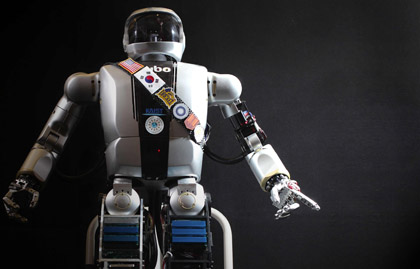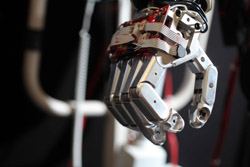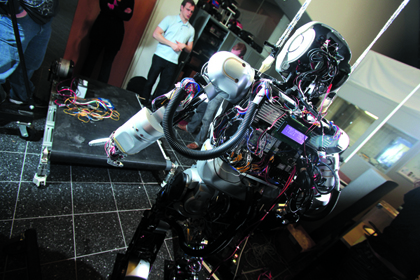
This article originally appeared in Philadelphia City Paper‘s annual Science Issue, published today. Read the special section, available on newsstands this week or online here.
Inside the sun-filled atrium of Drexel’s Bassone Research building, a blue, star-shaped balloon floats in the architectural web of gray steel that criss-crosses geometrically before six stories of glass paneling.
It’s just one of those metallic-looking, helium-filled tchotchkes you buy in a gift shop. But its mid-air rest speaks to Earth’s gravitational pull doing battle with the lightness of the gas inside, and its deflating mylar material brings to mind Kennedy-era NASA research.
It is widely recognized that the United States has let its once invigorated focus in science and technology slip from its fingers like that errant balloon.
Right now, American children score low in science literacy. A 2006 study ranked the U.S. 21st of 30 developed nations, President Obama pointed out last November when the White House launched its Educate to Innovate campaign, a $260 million private sector push to inspire the next generation of lab geeks.
Worse yet are statistics about women and minorities entering science fields. Only 18 percent of engineering bachelor’s degrees are awarded to women, and 11.1 percent to African-American and Hispanic students combined, according to a recent study by the American Society of Engineering Education [PDF].
So you could say there’s a bit of pressure on the shoulders of Drexel’s Jaemi HUBO, an adorable, anthropomorphic robot runt that acts like it just rolled out of bed.
Hunched slightly at its aluminum knees, its torque sensors delicately balance the four-foot-tall biped on platform feet. It takes tiny steps forward. With the push of a button, the hips twist right, then left, whirring like a radio-controlled car. Jaemi might look sleepy, if not for the Halo-like black visor that covers its Web cam eye.
A student technician directs Jaemi (pronounced “Jamie” ) to raise its right hand, fingers flanked by red circuit boards, its wrists wrapped in ribbon cable. Receiving a shove, the robot measures the exerted force, slumping its torso back like an annoyed, passive sibling.
See a video of Jaemi HUBO walking on a treadmill. Story continues below…
[tech]ame730JIDds[/tech]
Jaemi sleeps – well, recharges – at the Drexel Autonomous Systems Lab, a robotics laboratory on the first floor of the Bassone building and the headquarters for a five-year, $2.5 million federal grant from the National Science Foundation. Its goal is to train engineering students in international design collaboration and to create infrastructure to make the United States a world-leader in humanoid robotics.
Headed by Drexel University’s Dr. Paul Oh, a leader in the field, the project brings together a handful of international and local universities with specific expertise, like Bryn Mawr College, studying artificial intelligence, and University of Pennsylvania, researching mechanics. Researchers hope Jaemi will be able to interact with and learn from humans on its own.
Other schools, like Colby College in Maine and Virginia Tech, are helping to build a cost-effective system for small and mid-size universities that can’t afford a HUBO robot. They are creating a virtual simulator, a miniature-scale HUBO and an online portal that will provide remote-control access to test research on the full-size humanoid at Drexel.
Jaemi is presumably expensive, but pressed to disclose details, Oh declines. He says a price tag is a distraction to the grant’s goals. He compares it to racing team trying to win a grand prix. “It’s not just about the car, it’s about the pit crew, the training, the driver. It’s a larger challenge,” he says. “Nothing of this scale has been done anywhere in the world.”
 A large chunk of the funding has sent 20 undergraduate and doctoral students abroad to the Korea Institute of Advanced Science and Technology, a partner, where HUBO is developed. Equally important, though, is the project’s aim to improve public perception of robotics, and subsequently, youth interest in the field by giving robots a human face.
A large chunk of the funding has sent 20 undergraduate and doctoral students abroad to the Korea Institute of Advanced Science and Technology, a partner, where HUBO is developed. Equally important, though, is the project’s aim to improve public perception of robotics, and subsequently, youth interest in the field by giving robots a human face.
People have historically felt a disconnect with analog, autonomous, scrap-metal robots, Dr. Oh says. But humanoids robots are incredibly popular in Asian countries. “I was so impressed upon how the public was reacting to humanoids. Kindergartners to grandparents are enthralled by robots,” he says, that look like, walk beside and shake hands with their human counterparts.
Wanting to plug that gap here in the U.S., and with his extensive Rolodex of university contacts, Dr. Oh began in 2007 piecing together the international collaboration, which pairs top-notch Korean electromechanical design with leading American I.T. and artificial intelligence research. Hardware, meet software.
Bryn Mawr computer science undergrad Ashley Gavin, who’s researching walking algorithms for Jaemi HUBO, is working to make science more accessible to kids. Last fall, she used her robots-are-cool mentality to introduce suburban middle-schoolers to coding. Her students, a group of seven boys and five girls, used the scripting language Python to program a small robot to dance, draw pictures and solve mazes.
“I was one of many young women in this country that believed I was bad at math, probably because of one bad experience with one bad teacher,” Gavin says. “Maybe these girls or boys, who wouldn’t have otherwise taken a computer science course, will think it’s creative and fun.”
Dr. Oh sees Jaemi HUBO as a catalyst, not unlike John F. Kennedy’s 1961 call-to-arms for the United States to land a man on the moon. “Apollo was that period that created a new generation of scientists. In Asia, humanoid robotics is their equivalent of the space program,” he says.
“I hope that bringing humanoids to the U.S. can inspire and motivate American youth to pursue careers in science and engineering.”

Join the conversation!
Find news, events, jobs and people who share your interests on Technical.ly's open community Slack

Philly daily roundup: Women's health startup wins pitch; $204M for internet access; 'GamingWalls' for sports venues

Philly daily roundup: East Market coworking; Temple's $2.5M engineering donation; WITS spring summit

Philly daily roundup: Jason Bannon leaves Ben Franklin; $26M for narcolepsy treatment; Philly Tech Calendar turns one
